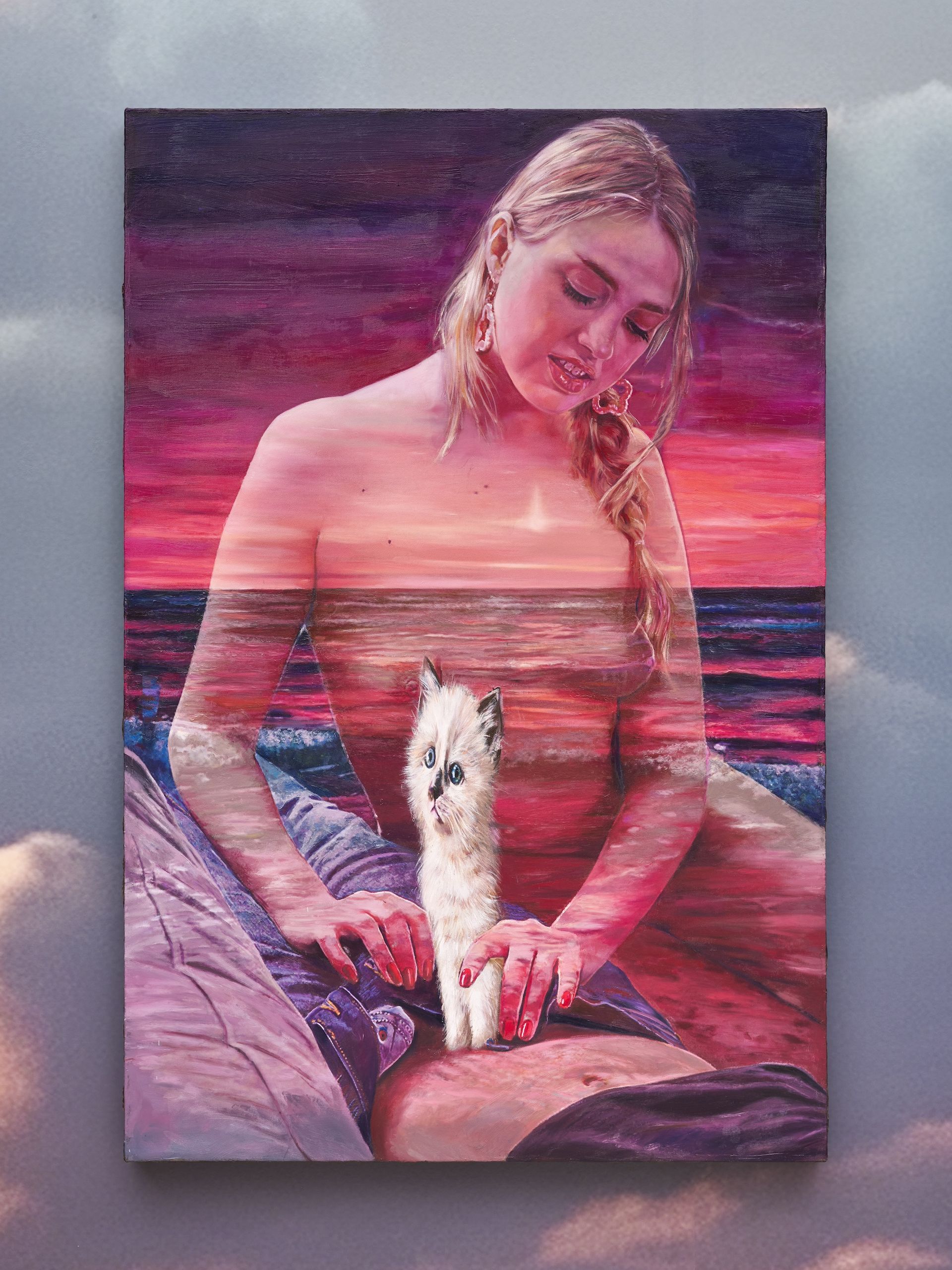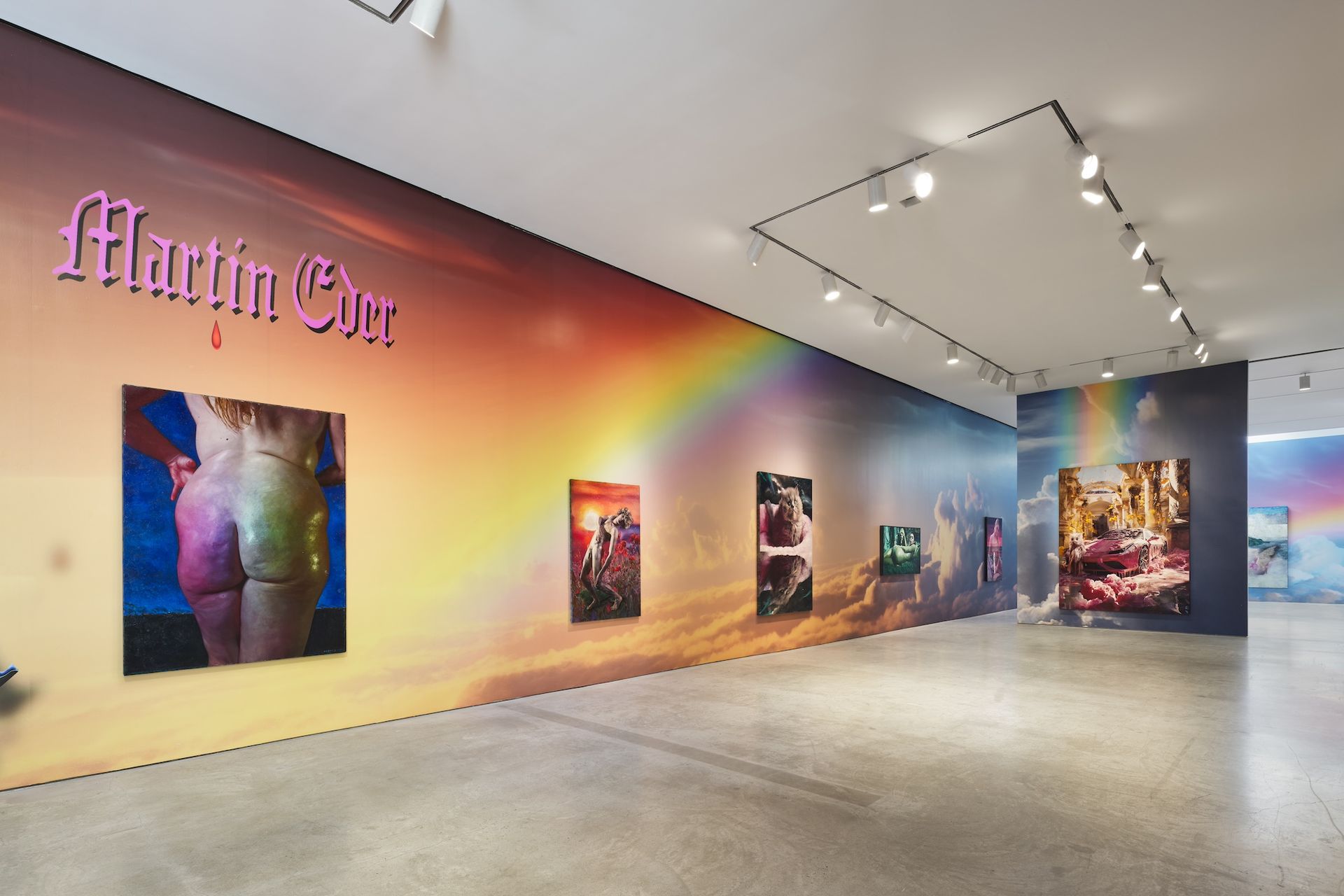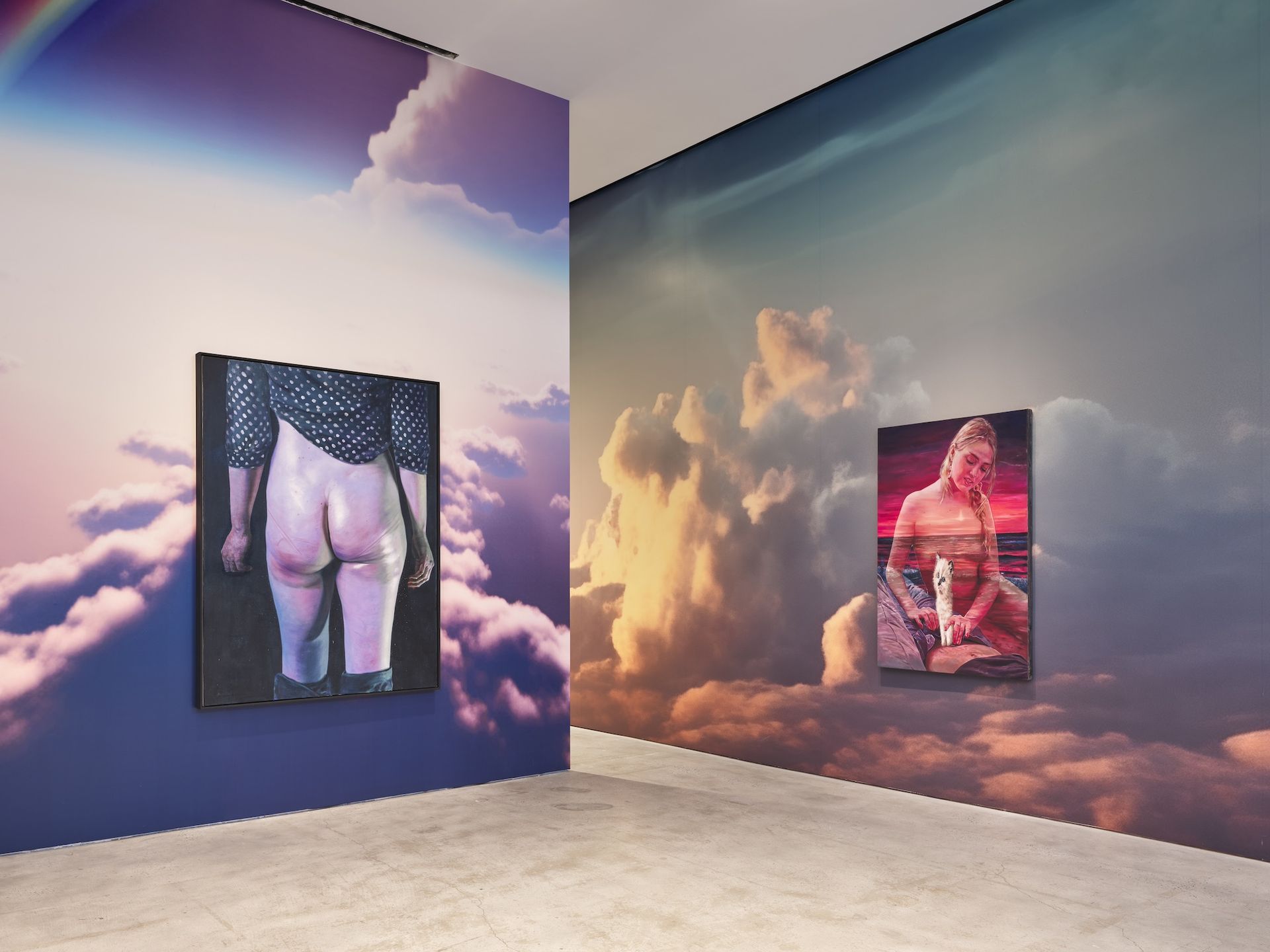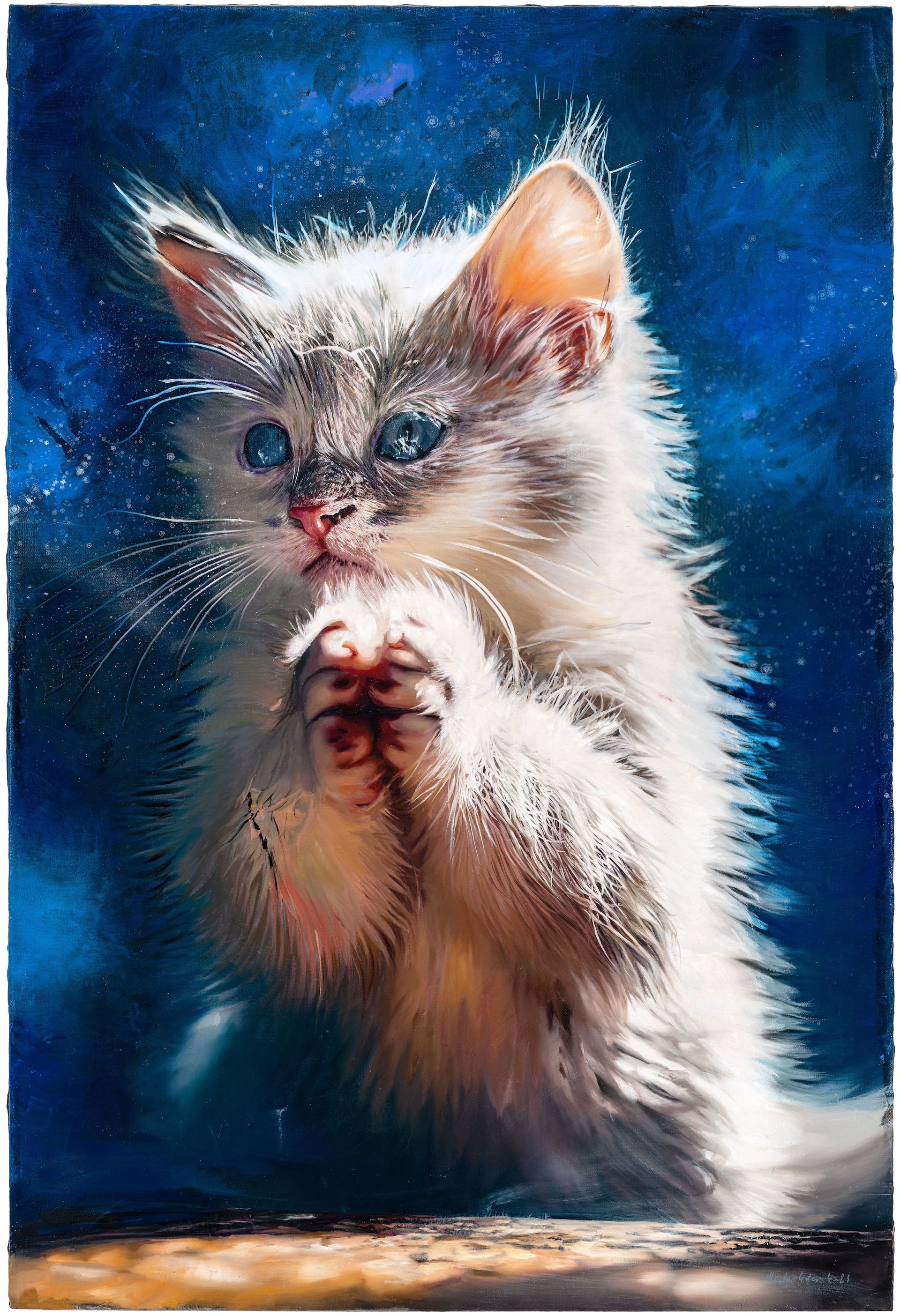The legacy of Marlborough Gallery, a leading dealership for decades on both sides of the Atlantic, does not evoke oil paintings of white fluffy kittens with pink wings floating over Bob Ross-like waterfalls, and 70in-tall oil-on-canvas close-ups of panty lines and cellulite. But Marlborough’s final contemporary art exhibition in New York is such an absurd, provocative, fantastical and refreshing departure from the norm that the gallery seems to have felt compelled to articulate a pre-emptive defense of Martin Eder’s DETOX (until 29 June).
The press release insists that Marlborough has always pushed the envelope and that the potentially problematic implications of a male painter painting female nudes (and some male nudes) in 2024 are merely projections of the audience, while Eder’s work does nothing more than mirror the content of the internet itself. This mirroring presumably exonerates the gallery, or at the very least cuts Eder some slack, since we are all complicit in what the internet has to offer.

Martin Eder, sunset, 2024 Courtesy of the artist and Marlborough Gallery, New York. Photo: Olympia Shannon
Still, the idea of defending against any fourth-wave feminist critique of the exhibition’s (hetero)sexualised male gaze by suggesting audience complicity in the source material is audacious. The fact that this is coming from the same gallery that showed Jackson Pollock, Egon Schiele, Barbara Hepworth and Lucian Freud is reason enough to visit the show. It is also certainly an unexpected form of defense for an exhibition that challenges not just the zeitgeist, but also the institution putting it on—leading up to the exhibition, the gallery’s external board, whose disagreements with gallery leadership are said to be one of the reasons for the gallery’s closure, resisted the show and even requested that it be cancelled. (Bacon and Freud: Conversations, on view concurrently in Marlborough’s upstairs space until 29 June, is a more predictable nod to the gallery’s history.)
Going out with a meow
Perhaps this exhibition could not have taken place if the gallery were not closing. The US political, social and digital climates are not very receptive to the kind of white-cis-het female objectification Eder deftly, unapologetically launches into here. The artist’s and the gallery’s commitment to the show amplify its shock factor: there is an implicit feeling of incredulity—”Really, this? Now?!”—that strangely enhances the experience.
Whatever internal and external politics led to its opening, DETOX is a sight to behold. It features floor-to-ceiling wallpaper depicting clouds and rainbows, upon which larger-than-life portraits of kittens and minimally clothed women and men are hung. The warm hues of the wallpaper’s cloudy vistas and rainbows balance some of the colder tones of the paintings without overpowering them, while also serving as a contextual throwback to early internet aesthetics, and even the standard Windows 95 clouds backdrop. If it may be used as an adjective, the show is very internet, in a way that perhaps Jon Rafman’s work could also be said to be very internet.

Installation view of Martin Eder: DETOX, 2024, at Marlborough Gallery, New York Courtesy of the artist and Marlborough Gallery, New York. Photo: Olympia Shannon
Eder’s aesthetics are a cross between a Ravensburger puzzle depicting unicorns flying over rainbows and the HBO series Euphoria. Especially in works like Steckbrief/profile (2012), with its blue-magenta disco lighting scheme illuminating oily skin and panty lines, Eder’s sense of composition is both captivatingly moody and oddly disturbing. The insistence in scale, larger than a computer screen (where the original and presumably private or voyeuristic image would have been seen), and much, much larger than reality, challenges viewers to behold the uncomfortable image as it dwarfs them.
The exaltation also introduces an element of humour. The choice to paint these images that one might have beheld on a clunky, beige monitor 20 years ago, completely changes their meaning. The voyeuristic and the pornographic no longer function as such when they are painted and recontextualised as Eder has done here. The resulting images are celebrations of the absurd. But of all the paths to absurdity, relying on found digital material of mostly female nudes does make Eder a voyeuristic painter, a trait that may read as a provocation to younger audiences.
For slightly older viewers, the show may evoke Jeff Koons’s Made in Heaven series (1989), although his style of erotic kitsch was more representative of the 1980s than Eder’s early 2000s online chat room aesthetics. Koons may be the more famous provocateur when it comes to challenging aesthetic norms with deliberately tasteless, often narcissistic, borderline pornographic visuals. Koons’s brand of male gaze art in the Made in Heaven series certainly eclipses Eder’s, and Koons’ sculptural focus at the time—evoking nothing so much as touristy road trip memorabilia—included an Americana sensibility that is absent in DETOX. This is perhaps due to the relative cultural homogeneity of the internet in the early 2000s, when visual representations of cats and naked women were more broadly Western, as opposed to Koons’s specifically American iconography.
Made in MySpace

Installation view of Martin Eder: DETOX, 2024, at Marlborough Gallery, New York, with Steckbrief/profile (2012, left) and sunset (2024, right) Courtesy of the artist and Marlborough Gallery, New York. Photo: Olympia Shannon
Internet culture is clearly a core component of Eder’s practice, but rather than presenting digital works, he is first and foremost a skilled painter. The hyperreal and the fantastical collide often in his compositions, and there is a constant shift between formal portraits and what look like screenshots from a fever dream. No matter how grounded or abstract the composition, the works are consistent in their commitment to the aesthetics of the internet. The source imagery in the show oscillates between gaudy souvenir shops, vintage pornography, and what the first generation of the DALL-E or Midjourney artificial intelligence (AI) image generators might have conjured if the prompt had been “pornographic fantasy novel covers”.
It might be tempting to consider the abundance of kittens in Eder’s paintings as offsetting the lewdness of the large-scale nudes, but this sense of balance is illusory. In the painting sunset (2024), for instance, there is a curiously distorted, elongated kitten in the hands of a naked woman whose translucent body sits in front of a crimson seascape. On closer inspection it is apparent that the actual source image likely showed the woman holding an erect penis, which Eder has seemingly replaced with an image of a cat that was distorted to cover an elongated shape, a phallic distortion that hints at the original image. In light of this realisation, one cannot help but reconsider the plethora of kittens in the gallery. Does A Glimpse of Infinity (2023) depict an internet kitty or another cloaked penis? This phallo-feline ambiguity contributes to the show’s tongue-in-cheek humour.

Martin Eder, A Glimpse of Infinity, 2023 Courtesy of the artist and Marlborough Gallery, New York. Photo: Uwe Walter
Eder’s hyperrealist painting style is particularly successful when presenting the disconnect between the textural sharpness of a kitten’s face on top of a fuzzier landscape, as though one is viewing a canvas in Photoshop with multiple layers copied and pasted onto one another from different sources, with different pixel densities. Collage is a fundamental part of Eder’s practice, as he pieces elements together digitally before painting them. Through unconventional proportions and shifting textures, he conveys a sense of collage, but these disjunctures accomplish something chronological, too: they underline that the work is not typical of the internet as we experience it today, but rather as it existed in the highly-customisable, kitschy, glitter-trail-at-the-end-of-your-cursor days of early MySpace—that time at the start of the millennium when things on the web did not have visual cohesion, compositional balance or pixel consistency.
With the show’s overabundance of sexual imagery, the walls erected by Marlborough’s press release may not be able to withstand much pressure. That the gallery seemingly felt the prevailing political climate required a pre-emptive defense of this exhibition is a somewhat disheartening testament to our time. Even so, DETOX accomplishes what it set out to do with incredible technical prowess and gusto.
- Martin Eder: DETOX, Marlborough Gallery, New York, until 29 June
